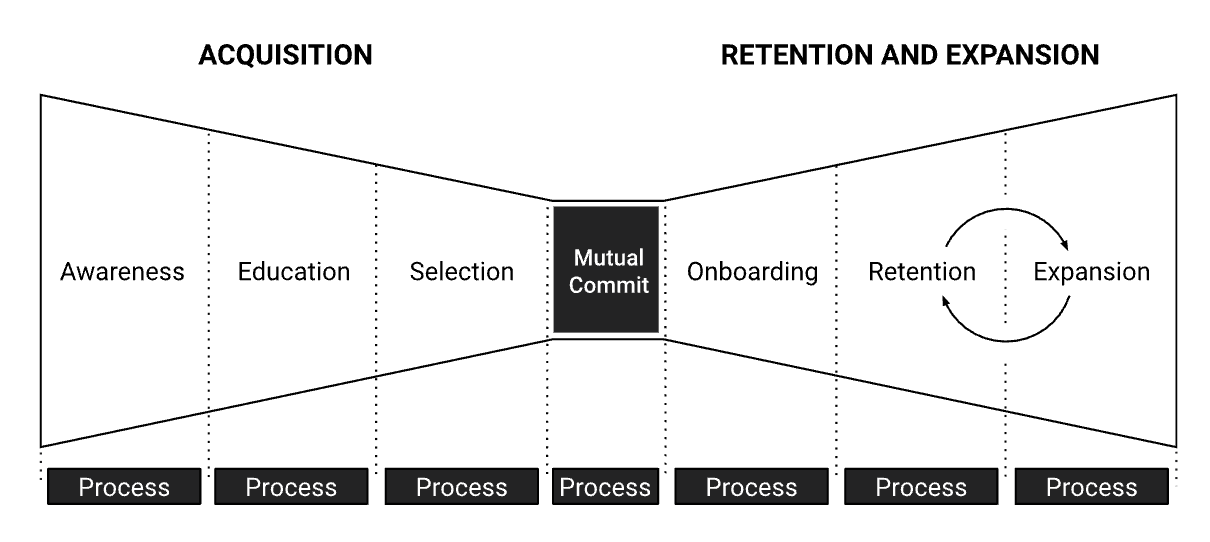Your funnel is only half the story
And why the fastest-growing companies don’t just generate pipeline
If you’re a CEO, founder, CMO, or GTM leader wondering why growth is stagnant, even though you’re generating pipeline, this is for you.
Most B2B SaaS teams say they have a growth strategy, but when you look closer, what they really have is a pipeline strategy.
Because real growth comes from three levers working together:
1- Generating pipeline
2- Retaining customers
3- Expanding within accounts
This is how high-performing SaaS teams approach the full customer journey:
And the numbers back it up:
A 1% boost in retention can increase revenue 2x more than the same lift in acquisition (Maxio)
A 1% improvement in expansion has nearly 4x the impact of acquisition (Maxio)
For SaaS companies with strong Net Revenue Retention (NRR ≥ 100%), growth rates are double (ChartMogul)
If even one of those levers is weak, your growth slows, or gets a lot more expensive.
And ironically, the one area most teams do invest in, pipeline, is often the most misused.
The pipeline problem
If you ask people on LinkedIn, everything is dead:
But here’s the reality:
SEO, outbound, ABM, demand gen, conferences – every one of those channels can work. And every one can fail.
The real issue isn’t the channels. It’s the outdated playbooks most teams are still running, and operating under the assumption that pipeline = growth.
In many B2B companies, pipeline gets all the attention. But it’s often the least strategic part of the growth engine.
In fact, across dozens of B2B SaaS and AI companies, I keep seeing the same five problems pop up when it comes to pipeline generation:
1- Weak positioning & messaging
2- Inaccurate or incomplete ICP definition
3- Over-investment in short-term strategies
4- Tactic overload- too many motions, not enough cohesion
5- Tracking the wrong metrics (volume over buyer intent)
All of this leads to pipeline that’s inefficient, inconsistent, or flat. And yes, it all comes back to your GTM foundations (or lack of them…).
And that’s the real challenge:
If the one part you’re actively resourcing (pipeline) isn't driving efficient growth, what happens when the other two levers are barely touched?
Where expansion & retention come in
If you treat retention and expansion as support functions, something CS or AMs handle post-sale, you won’t scale efficiently or predictably.
And yet, many teams still:
Delay investing in retention until churn becomes a problem
Hope expansion happens naturally (it doesn’t)
Or worse, treat these levers like they’re outside the GTM team's scope
But don’t get me wrong, I’m not saying you need to invest in all three equally.
The right balance depends on your stage of growth and business model.
Early on, pipeline may take priority. But even then, retention and expansion should be designed in, so they’re not playing catch-up later.
At growth stage, that balance shifts:
Retention becomes a key efficiency driver, and expansion often delivers the highest ROI. You’ve already paid to acquire the customer, so now the question is how much value you can unlock over time.
So, here’s the short version:
Growth = Pipeline + Retention + Expansion
What does that look like in practice?
For retention:
Start at acquisition – Make sure what Sales promises matches the real product experience
Track leading indicators – Monitor product usage depth, onboarding milestones, and product adoption, not just churn
Close the loop – Feed CS insights back into product, marketing, and onboarding
Operationalize it – Use structured playbooks for renewals, at-risk accounts, and lifecycle engagement
For expansion:
Design for it early – Map expansion paths (more teams, seats, features) from the start
Trigger-based motions – Use product usage or business milestones to prompt upsell/cross-sell
Align CS + Sales – Treat expansion as a revenue motion, not a handoff
Make value visible – Continuously surface outcomes that justify growth, for the buyer and for your team
GTM is an ecosystem
You get where I’m going. GTM isn’t a set of handoffs, it’s a system where:
Brand & demand gen power acquisition/pipeline
Acquisition shapes onboarding
Onboarding drives retention
Retention unlocks expansion
Expansion feeds back into brand and pipeline
Simply put, success comes from the interplay between channels, growth levers, and teams – not isolated efforts.
The goal is to optimize each part of the journey in a way that strengthens the whole GTM.
The best teams do this by building repeatable processes across every stage, from first touch to expansion.
Between the lines
If you’re thinking, “Cool, but how do I know where I’m strong or where I’m off balance?”
Don’t worry, I’ve got you 🙂
I put together a simple resource that helps you take a quick look at your GTM across pipeline & revnue, retention, and expansion.
It’s the same lens I use when working with SaaS teams to spot what’s working, what’s not, and where to focus to improve their GTM.
Grab the free GTM self-check here (please make a copy of the file so you can fill out your score).
And if you want help thinking through it, just hit reply or comment.
Thanks for reading & see you next Saturday!
Alon
P.S. New here? Check out the latest topics.
P.P.S. When you're ready, here are 3 ways I can help you.






